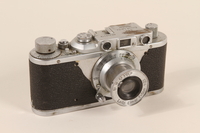Overview
- Description
- The Herlinger family papers consist primarily of identification documents for Ivo and Elsa Herlinger, who lived as refugees from the Nazis in Italy during World War II, and later immigrated to the United States. The majority of the documents are items such as identification cards, passports, a birth certificate, and a marriage certificate. Other items of identification include verification of employment for Ivo, and his declaration of intent to the United States.
The Herlinger family papers consist primarily of identification documents for Ivo and Elsa Herlinger, who lived as refugees from the Nazis in Italy during World War II, and later immigrated to the United States. The majority of the documents are items such as identification cards, passports, a birth certificates, and a marriage certificate. Other items of identification include records needed for immigration to the United States, such as a verification of employment for Ivo, and his declaration of intent. The naturalization papers of both Elsa and Ivo are in this collection. Also included are photographs of the Herlinger family, some correspondence regarding taxes to a cemetery in Zagreb, and identification papers for a Xene West, whose relation could not be identified. - Date
-
inclusive:
1923-1956
bulk: 1923-1956
- Credit Line
- United States Holocaust Memorial Museum Collection, Gift of Allan and Lea Kaluzna
- Collection Creator
- Herlinger family
- Biography
-
Ivek (Ivo) Herlinger was born in 1902 in Zagreb, Croatia. He worked as a representative for Remington Office Machines. While working there, he met and later married Elsa Spitzer, who worked for the company as a legal secretary. The couple gave birth to their daughter, Lea, in 1938. In 1941, as axis powers invaded Yugoslavia and the independent state of Croatia was formed, the Herlinger family was told to report to a labor camp. Instead, they fled Zagreb and split up, with Lea being sent to Ivo’s sister, Zlata and Elsa staying with friends. Ivo posed as a train conductor, traveled to Trieste, Italy, and then paid a man to bring his family to join him. From there, the family stayed in Castel Guiliano, Italy for 18 months living in an attic above a store with 21 other people. When they were warned that Germans were approaching, the family fled to Rome. Elsa, Lea, and Zlata lived in a convent, while Ivo, and his brothers Arthur and Otto, lived in a monastery. Ivo and Elsa eventually moved to an apartment under false identities: Giovani and Lena Fabiani. After liberation, the family lived as stateless refugees in Italy, until they were granted visas to immigrate to the United States. With assistance from the Hebrew Immigrant Aid Society (HIAS), the Herlingers traveled aboard the "General Harry Taylor," arrived in New York, and eventually settled in Chicago.
Physical Details
- Genre/Form
- Certificates. Identification cards. Passports. Photographs.
- Extent
-
11 folders
- System of Arrangement
- The Herlinger family papers are arranged as a single series.
Rights & Restrictions
- Conditions on Access
- There are no known restrictions on access to this material.
- Conditions on Use
- Material(s) in this collection may be protected by copyright and/or related rights. You do not require further permission from the Museum to use this material. The user is solely responsible for making a determination as to if and how the material may be used.
Keywords & Subjects
- Topical Term
- Holocaust, Jewish (1939-1945)--Croatia. World War, 1939-1945--Refugees--Italy. Jewish Refugees--Italy.
- Geographic Name
- United States--Emigration and immigration--History--20th century. Zagreb (Croatia) Rome (Italy) Trieste (Italy)
- Personal Name
- Herlinger, Otto. Herlinger, Arthur. Herlinger, Zlata. Herlinger, Ivo. Herlinger, Elsa. Kaluzna, Lea Herlinger. West, Xene.
- Corporate Name
- General Harry Taylor (Ship) HIAS (Agency)
Administrative Notes
- Holder of Originals
-
United States Holocaust Memorial Museum
- Legal Status
- Permanent Collection
- Provenance
- The papers were donated to the United States Holocaust Memorial Museum in 2005 by Allan and Lea Kaluzna.
- Record last modified:
- 2023-03-16 11:05:55
- This page:
- https://collections.ushmm.org/search/catalog/irn517349
Additional Resources
Download & Licensing
In-Person Research
- Available for Research
- Plan a Research Visit
-
Request in Shapell Center Reading Room
Bowie, MD
Contact Us
Also in Lea Herlinger Kaluzna family collection
The collection consists of a Leica camera, documents, and photographs relating to the experiences of Elsa, Ivo, and Lea Herlinger before the Holocaust in Yugoslavia, during and after the Holocaust in Italy, including the years they lived in hiding, and after their 1950 emigration to the United States.
Date: 1923-1950

Chrome Leica II 35mm camera used by a Yugoslav refugee to document his family's life in hiding
Object
Chrome Leica 35mm camera used by Ivo Herlinger while he was living in hiding in Italy from 1941-1944. After Nazi Germany invaded Yugoslavia in June 1941, Ivo and his wife, Elsa, fled Zagreb to avoid internment in a German labor camp. They had to leave their 2 year old daughter, Lea, with an aunt. A few months later, using jewels they had sewn into the lining of their clothes, they paid a student to bring Lea to them in Trieste, Italy. The family spent the next three years hiding under false identities in Rome and other towns in Italy, where Ivo used his camera to document their daily life. When the family emigrated to the United States in October 1950, US customs officials purposely scratched the top of the camera to prevent resale.



